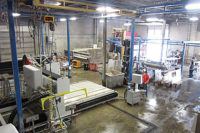For me, this tour is generally a chance to see the latest developments in large-scale stone production. Whether it is modern quarrying methods and equipment or the latest block-processing machinery, this tour always gives me an opportunity to see some of the most up-to-date technology at use in the field today.
The most recent Marmomacc education program, which took place last fall, certainly provided me with a look at these large-scale operations. In this issue, you will see examples of a marble quarrier utilizing the very latest chainsawing technology for block extraction (page 62) and a block-processor using modern multi-wire technology for slabbing (page 68).
But in addition to seeing these operations, my tour also included visits to two stoneworking shops that produced specialty work on a smaller scale, but were every bit as impressive.
We are featuring both of these shops as the “Fabricator Case Studies” in this issue of Stone World, and both operations — Vicentina Marmi (page 42) and Decormarmi (page 48) — have a somewhat similar story on how they were formed as well as their current operational model.
Formed in 1999, Vicentina Marmi was established by a group of craftsmen with a long history in the trade, who felt there was a niche market for processing and marketing high-end decorative stone products.
Nearly four decades earlier, artisan Angelo Farinon and his brothers formed Decormarmi as a small stoneworking studio to provide architectural pieces.
Today, both of these operations utilize much of the same equipment that I find in the North American stoneworking shops — CNC routers, waterjet cutting equipment, bridge saws, etc. They also have some more advanced equipment, such as five-axis stoneworking and milling machines and lathes.
But even though the equipment list in each shop is noteworthy, I was even more impressed by the level of talent that I saw on a personal level. Whether it was a saw operator, an artisan hand-chiseling an intricate design or someone putting the finishing touches on a one-of-a-kind stone furnishing, the pride of craftsmanship was evident in the faces of every worker I saw. When a company representative tells me about the “Made in Italy” tradition, visits like these show me exactly what they are talking about.
So how does this relate back to us here in America? Frankly, I often see this level of pride and craftsmanship in the fabrication shops I visit in the U.S.; it’s just that many of the shop owners are either too busy or too modest to promote it. At a time when our industry is still facing great challenge — including the continual presence of low-quality, lowball competitors — it’s not a bad idea for the quality shops out there to promote their craftsmanship; to illustrate to the public why they can’t really sell countertops for $25/foot.
No matter how many lowballers are out there, we need to remember that stone is not a commodity item; it is a premium building product that has been associated with quality and elegance for centuries. We need to promote it that way, because that is a statement that the folks from Corian will simply never get the chance to say.

